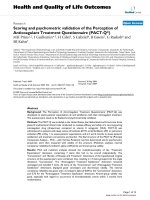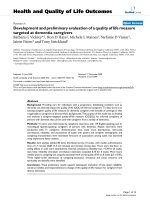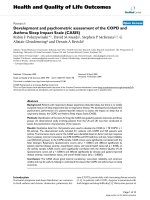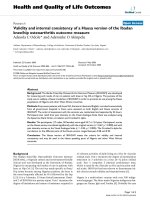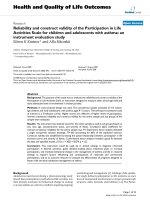Báo cáo hóa học: " Physical and Electrical Performance of Vapor–Solid Grown ZnO Straight Nanowires" doc
Bạn đang xem bản rút gọn của tài liệu. Xem và tải ngay bản đầy đủ của tài liệu tại đây (217.09 KB, 4 trang )
NANO EXPRESS
Physical and Electrical Performance of Vapor–Solid Grown ZnO
Straight Nanowires
J. Y. Li Æ H. Li
Received: 14 October 2008 / Accepted: 11 November 2008 / Published online: 3 December 2008
Ó to the authors 2008
Abstract Physical and electrical properties of wurtzitic
ZnO straight nanowires grown via a vapor–solid mechanism
were investigated. Raman spectrum shows four first-order
phonon frequencies and a second-order Raman frequency
of the ZnO nanowires. Electrical and photoconductive per-
formance of individual ZnO straight nanowire devices was
studied. The results indicate that the nanowires reported
here are n-type semi-conductors and UV light sensitive, and
a desirable candidate for fabricating UV light nanosensors
and other applications.
Keywords Nanostructures Á Nanosensors Á ZnO
Introduction
Wurtzite structure zinc oxide (ZnO) is a very important
II–VI group semiconductor. It has a direct wide bandgap of
3.37 eV, higher exciton binding energy (60 meV for ZnO
vs. 28 meV for GaN), and higher optical gain (300 cm
-1
for ZnO versus 100 cm
-1
for GaN) at room temperature
[1–4]. Recently, ZnO has attracted extensive interest for its
applications in numerous fields. It is of interest for low-
voltage and short wavelength (green or green/blue) electro-
optical devices such as light emitting diodes and laser
diodes. It also can be widely used as transparent ultraviolet
(UV)-protection films, transparent conducting oxide
materials, piezoelectric materials, electron-transport med-
ium for solar cells, chemical sensors, photo-catalysts, and
so on [1–4].
In the past few years, extensive reports regarding the
study of ZnO nanowires continue at a dizzying pace for
their great prospects in fundamental physical science, novel
nano-technological applications, and significant potential
for nano-optoelectronics, and nano-ZnO was suggested to
be the next most important nano-material after carbon
nanotubes [5–14].
Herein, we report the physical and electrical properties
of vapor–solid grown ZnO straight nanowires. The ZnO
straight nanowires were grown via a facile catalyst-free
method on amorphous fused quartz surfaces on a large-
scale. Raman spectra of the ZnO nanowires were investi-
gated. Individual ZnO straight nanowire devices were
fabricated, and photoconductive and electrical studies were
carried out with the single ZnO nanowire devices.
Experimental
The system used to grown ZnO straight nanowires is
similar to that in our previous report [15], and the ZnO
nanowires were grown in a horizontal fused quartz tube
inside a conventional tube furnace. The reaction through
which the ZnO nanowires synthesized can be expressed as:
Zn þ H
2
O ! ZnO þ H
2
As a precursor, high pure metal zinc powders were
loaded into the center of the tube. The vapor H
2
O was
carried into the quartz tube through the flow of high pure
argon. At high temperature (700–800 °C) zinc reacted with
vapor H
2
O and produced ZnO nanowires. The nanowires
were deposited on amorphous fused quartz substrates.
J. Y. Li (&)
Department of Physical Chemistry, University of Science and
Technology Beijing, Beijing, China
e-mail:
H. Li
Institute of Microstructure and Properties of Advanced Material,
Beijing University of Technology, Beijing, China
123
Nanoscale Res Lett (2009) 4:165–168
DOI 10.1007/s11671-008-9218-1
Results and Discussion
X-ray diffraction (XRD) examination was used to assess
the overall crystallographic properties and phase purity of
the product. Figure 1 shows a powder XRD pattern of the
as-grown ZnO nanowires and it reveals that the nanowires
are composed of hexagonal ZnO. The positions of the XRD
peaks show good agreement with those of the reported
standard data of hexagonal ZnO with lattice constants
a = 0.3250 nm and c = 0.5207 nm (Joint Committee on
Powder Diffraction Standards (JCPDS) Card No. 36–
1451). The strong intensities of the ZnO diffraction peaks
relative to the background signal indicate that the as-grown
nanowires are high pure hexagonal phase ZnO. The
structure of the ZnO nanowires was further characterized
by selected area electron diffraction (SAED). Inset of
Fig. 1 (right) is an SAED pattern of an individual ZnO
nanowire. The SAED pattern can be indexed as a hexag-
onal structure with lattice constants of a = 0.325 nm and
c = 0.52 nm, which is in good agreement with the XRD
result. The SAED pattern reveals the single-crystalline
hexagonal phase nature of the ZnO nanowires. Inset of
Fig. 1 (left) is a typical field emission scanning electron
microscope (FESEM) image of the ZnO nanowires, and it
shows the nanowires with diameters of several tens nano-
meters. Most of the nanowires have length of several to
tens microns. The nanowires are straight and most of them
show smooth surface and no ramification over their length.
The vapor–liquid–solid (VLS) mechanism is common
for the catalyzed growth of one-dimensional materials, and
catalyst particles are typically detected at tips of the VLS
grown one-dimensional materials [16]. In the present case,
however, the VLS mechanism is not responsible for
explaining the growth of the ZnO nanowires. This is
because there is no catalyst used in the growing process,
and no catalyst particles are detected at the ZnO nanowire
tips. It appears the growth of the ZnO straight nanowires
reported here occurs via a vapor–solid (VS) mechanism
[17]. The vapor H
2
O was carried into the quartz tube and
transported downstream by the flow of argon. At the center
of the tube furnace, metal zinc vaporized and reacted with
vapor H
2
O to generate ZnO vapor. Then the ZnO vapor
deposited on the substrates and nucleation of wurtzite
structure ZnO nanoparticles (nanorods) took place.
Through a VS growth mechanism, the ZnO nanoparticles
(nanorods) prolonged and the solid ZnO long nanowires
were formed.
Raman scattering spectrum is a very useful tool for the
structure characterization of nanomaterials. Wurtzite
structure ZnO possesses four atoms per primitive cell and
the space group of wurtzite structure is C
6v
4
(P6
3
mc) with
all atoms occupying the C
3v
sites. According to the factor
group analysis, single crystal wurtzite structure ZnO pos-
sesses eight sets of optical phonon modes near the zone
center. The modes are classified into Raman allowed
(A
1
? E
1
? 2E
2
), infrared allowed (A
1
? E
1
), and both
Raman and infrared silent (2B
1
). The A
1
and E
1
modes,
corresponding to optical phonons, will split into a longi-
tudinal-optical (LO) and a transverse-optical (TO)
component due to the macroscopic electrical field associ-
ated with the longitudinal vibration [18–20]. The high
frequency E
2
mode involves only the oxygen atoms, and
the low frequency E
2
mode is associated with the vibration
of the heavy Zn sub-lattice [21].
Figure 2 is a Raman scattering spectrum of the ZnO
straight nanowires in the frequency range from 250 to
750 cm
-1
. Four first-order Raman-active phonon bands of
wurtzite structure ZnO are observed. The most intense peak
at 440 cm
-1
corresponds to non-polar optical phonon E
2
(high) of wurtzitic ZnO, and it is a particularly important
feature characteristic of hexagonal phase ZnO. The bands
380 cm
-1
and 410 cm
-1
agree with phonon vibration fre-
quencies of A
1
(TO) and E
1
(TO) modes of wurtzite ZnO,
respectively. The peak at 586 cm
-1
is attributed to the E
1
(LO) mode of hexagonal ZnO, and it is associated with
oxygen deficiency. The Raman peak at 334 cm
-1
is
assigned to the second-order Raman spectrum arising from
zone-boundary phonons of hexagonal ZnO, and the data
agree well with previous reports on wurtzite structure ZnO
crystal samples [20] and thin films [21].
It can be also found from Fig. 2 that the Raman spec-
trum of the ZnO nanowires is slightly asymmetrical with
respect to those of ZnO crystals [20]. This asymmetrical
spectrum shape is mainly attributed to the confinement
effects of phonons in nanowire samples. The phonons can
Fig. 1 Room temperature powder XRD pattern of the ZnO straight
nanowires using Cu Ka radiation and the (hkl) values of the
hexagonal ZnO are specified about the diffraction peaks. Inset (left)
is a typical FESEM image of the nanowires, and inset (right) is a
SAED pattern of the ZnO nanowire
166 Nanoscale Res Lett (2009) 4:165–168
123
be confined within the nanosized systems and thus phonons
other than those of Brillouin-zone center can also con-
tribute to the Raman spectrum, which leads to the
asymmetrical shapes of the Raman spectrum. Such an
asymmetrical shape of the Raman modes associated with
the phonon confinement effects in ZnO nano-sized systems
are also reported on ZnO nanoparticles [22].
To test photoconduction of the individual ZnO straight
nanowires, single ZnO nanowire field effect transistors
were fabricated by e-beam lithographic technique [23], and
the photoconductive studies were carried out with the
single ZnO nanowire devices. The electrical measurements
were performed at room temperature. Figure 3a shows the
room temperature current versus voltage plots of a single
ZnO nanowire device measured with and without 254 nm
short wave UV light illumination. The linear I–V behavior
indicates the ohmic contacts between the electrodes and the
ZnO nanowire. As is expected for semiconducting ZnO
nanowires, under UV illumination, the conductivity of the
nanowire greatly increases due to the photo-generated
carriers in the semiconducting ZnO nanowire. UV light
(254 nm) has photon energy of 4.88 eV, large enough to
excite electrons across the bandgap of ZnO (3.37 eV). The
photoconduction result indicates the ZnO straight nano-
wires reported here are UV light sensitive and a desirable
candidate for nano-scale UV light sensors. Figure 3bisa
set of typical room temperature I
sd
vs. V
sd
data of the
individual ZnO nanowire device recorded at different gate
voltages. The conductance of the ZnO nanowire decreases
with increasingly negative gate voltages. From the gate-
dependence of the I
sd
vs. V
sd
curves, the ZnO nanowire can
be identified as a very fine n-type semiconductor. In other
words, the transport through the ZnO nanowires is domi-
nated by negative carries. The results reveal that the
straight ZnO nanowires reported here can serve as building
blocks for the assembly of nanodevices for applications in
nanoscale science and technology. The ZnO Nanowires
grown from this facile method is large-scale growth, cheap
(only use amorphous fused quartz substrates), and pure (no
contamination from catalyst), this facile technique will
greatly facilitate the large-scale industrial production and
applications of ZnO Nanowires.
Conclusions
In conclusion, the physical and electrical properties of
vapor–solid grown hexagonal ZnO straight nanowires were
investigated. The Raman spectrum shows four first-order
phonon frequencies of E
2
(high) = 440 cm
-1
, A
1
(TO) =
380 cm
-1
, E
1
(TO) = 410 cm
-1
, and E
1
(LO) = 586
cm
-1
; and a second-order Raman spectrum at 334 cm
-1
which arises from zone-boundary phonons of hexagonal
ZnO. Individual ZnO straight nanowire devices were fab-
ricated and the electrical and photoconductive studies were
carried out with the single nanowire devices. The result
Fig. 2 Raman-scattering spectrum of the ZnO straight nanowires
measured with a 488 nm excitation at room temperature
Fig. 3 a Room temperature current versus voltage plots of an
individual ZnO straight nanowire device measured with and without
254 nm UV light illumination; inset: SEM image of the individual
ZnO nanowire device. b Room temperature gate-dependent I
sd
vs V
sd
curves of the individual ZnO nanowire device
Nanoscale Res Lett (2009) 4:165–168 167
123
indicates that the ZnO straight nanowire is a fine n-type
semiconductor and a desirable candidate for fabricating
UV light nano-sensors and other applications.
References
1. E.M. Wong, P.C. Searson, Appl. Phys. Lett. 74, 2939 (1999). doi:
10.1063/1.123972
2. E.A. Meulenkamp, J. Phys. Chem. B 102, 5566 (1998). doi:
10.1021/jp980730h
3. S. Choopun, R.D. Vispute, W. Noch, A. Balsamo, R.P. Sharma,
T. Venkatesan, A. Iliadis, D.C. Look, Appl. Phys. Lett. 75, 3947
(1999). doi:10.1063/1.125503
4. M.H. Huang, S. Mao, H. Feick, H.Q. Yan, Y. Wu, H. Kind,
E. Weber, R. Russo, P.D. Yang, Science 292, 1897 (2001). doi:
10.1126/science.1060367
5. J.Y. Lao, J.G. Wen, Z.F. Zen, Nano Lett. 2, 1287 (2002). doi:
10.1021/nl025753t
6. M. Law, L.E. Greene, J.C. Johnson, R. Saykelly, P.D. Yang, Nat.
Mater. 4, 455 (2005). doi:10.1038/nmat1387
7. Z.L. Wang, J.H. Song, Science 312, 242 (2006). doi:
10.1126/science.1124005
8. J.V. Foreman, J.Y. Li, H.Y. Peng, S.J. Choi, H.O. Everitt, J. Liu,
Nano Lett. 6, 1126 (2006). doi:10.1021/nl060204z
9. B. Xiang, P.W. Wang, X.Z. Zhang, S.A. Dayeh, D.P.P. Aplin,
C. Soci, D.P. Yu, D.L. Wang, Nano Lett. 7, 323 (2007). doi:
10.1021/nl062410c
10. X. Shen, P.B. Allen, J.T. Muckerman, J.W. Davenport, J.C.
Zheng, Nano Lett. 7, 2267 (2007). doi:10.1021/nl070788k
11. L. Shi, Y.M. Xu, S.K. Hark, Y. Liu, S. Wang, L. Peng, K. Wong,
Q. Li, Nano Lett. 7, 3559 (2007). doi:10.1021/nl0707959
12. Y.M. Oh, K.M. Lee, K.H. Park, Y. Kim, Y.H. Ahn, J. Park, S.
Lee, Nano Lett. 7, 3681 (2007). doi:10.1021/nl071959o
13. S. Ruhle, L.K. van Vugt, H.Y. Li, N.A. Keizer, L. Kuipers, D.
Vanmaekelbergh, Nano Lett. 8, 119 (2008). doi:10.1021/
nl0721867
14. W.K. Hong, J.I. Sohn, D.K. Hwang, S. Kwon, G. Jo, S. Song,
S. Kim, M.E. Welland, T. Lee, Nano Lett. 8, 950 (2008). doi:
10.1021/nl0731116
15. J.Y. Li, X.L. Chen, H. Li, M. He, Z.Y. Qiao, J. Cryst. Growth
233, 5 (2001). doi:10.1016/S0022-0248(01)01509-3
16. A.M. Morales, C.M. Lieber, Science 279, 208 (1998). doi:
10.1126/science.279.5348.208
17. J.Y. Li, H.Y. Peng, J. Liu, H.O. Everitt, Eur. J. Inorg. Chem. 3172
(2008). doi:10.1002/ejic.200701306
18. J.M. Calleja, M. Cardona, Phys. Rev. B 16, 3753 (1977). doi:
10.1103/PhysRevB.16.3753
19. M. Cardona, G. Guntherodt (eds.), Topics in Applied Phys
(Vol. 50)—Light Scattering in Solids II (Springer-Verlag, Berlin,
1982)
20. T.C. Damen, S.P. Porto, B. Tell, Phys. Rev. 142, 570 (1966). doi:
10.1103/PhysRev.142.570
21. M. Koyano, P. Quocbao, L.T. Thanhbinh, L. Hongha, N. Ngoc-
long, S. Katayama, Phys. Status Solidi (a) 193, 125 (2002).
doi:10.1002/1521-396X(200209)193:1\125::AID-PSSA125[
3.0.CO;2-X
22. Y. Du, M.S. Zhang, J. Hong, Y. Shen, Q. Chen, Z. Yin, Appl.
Phys. A 76, 171 (2003). doi:10.1007/s003390201404
23. J.Y. Li, L. An, C.G. Lu, J. Liu, Nano Lett. 6, 148 (2006). doi:
10.1021/nl051265k
168 Nanoscale Res Lett (2009) 4:165–168
123

